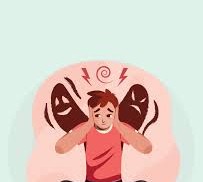Navigating the Storm: Understanding and Managing Generalized Anxiety Disorder (GAD)


What Is Generalized Anxiety Disorder and How Does It Affect Daily Life?
Generalized Anxiety Disorder (GAD) is more than just occasional worry—it’s a persistent and often overwhelming mental health condition that can affect every aspect of a person’s life. Many people may ask: Why do I feel anxious all the time, even when there’s no obvious reason? This is the core of GAD—constant worry and tension without clear triggers.
- GAD is characterized by excessive worry lasting for six months or longer.
- It affects thoughts, emotions, and physical health.
- Common signs include fatigue, restlessness, difficulty concentrating, and sleep problems.
- It can impact work performance, relationships, and quality of life.
GAD doesn’t stem from one single event—it often develops gradually and may be tied to a combination of genetic, environmental, and psychological factors. Individuals with GAD find it difficult to control their worry, even when they logically understand there is no immediate threat or problem.
Common Triggers and Causes of GAD
What contributes to the development of generalized anxiety? GAD often arises from a mix of internal and external factors, and understanding these can help individuals manage their anxiety more effectively.
- Biological influences: Imbalance of brain chemicals like serotonin and dopamine.
- Genetics: A family history of anxiety or other mental health disorders.
- Life experiences: Traumatic or stressful events, such as abuse or significant loss.
- Personality traits: Individuals who are perfectionists or have low self-esteem may be more prone.
- Substance use: Caffeine, alcohol, and certain medications can trigger or worsen symptoms.
Recognizing the cause doesn’t always provide an instant cure, but it’s an important step in building awareness and seeking the right treatment.
Recognizing the Symptoms of Generalized Anxiety Disorder (GAD)
Many individuals struggle to distinguish between general stress and a diagnosable anxiety disorder. So, how can you tell if what you’re experiencing is GAD?
- Constant worry or fear, even when there’s no apparent reason.
- Muscle tension, headaches, or digestive problems.
- Difficulty sleeping or staying asleep.
- Irritability or feeling on edge most of the time.
- Trouble concentrating or feeling that the mind “goes blank.”
The symptoms are persistent and can last for months or years without proper intervention. Recognizing them early can significantly improve outcomes through timely treatment and lifestyle changes.
The Emotional and Physical Impact of Generalized Anxiety
Why is untreated anxiety so harmful? GAD doesn’t only affect mental well-being—it also has serious physical consequences.
- Emotional effects: Constant fear, mood swings, emotional exhaustion.
- Physical effects: Increased heart rate, sweating, digestive issues, and frequent illnesses.
- Behavioral changes: Avoiding social interactions, missing work or school, and isolating from loved ones.
- Long-term risks: May lead to depression, substance abuse, or chronic physical health conditions.
Living with GAD is like carrying an invisible weight that never goes away. This burden often reduces a person's ability to function in everyday settings, affecting both personal and professional relationships.
Effective Strategies for Coping and Treatment
Can Generalized Anxiety Disorder(GAD) be managed successfully? Absolutely. With the right tools and support, people living with Generalized Anxiety Disorder(GAD) can lead fulfilling lives.
- Therapy: Cognitive Behavioral Therapy (CBT) is one of the most effective treatments.
- Lifestyle changes: Regular exercise, healthy sleep habits, and mindfulness practices can help reduce symptoms.
- Support systems: Joining support groups or talking to trusted friends and family members can ease emotional strain.
- Stress management: Learning relaxation techniques like meditation, deep breathing, or yoga.
Treatment plans vary depending on the individual, and it may take time to find the right combination of approaches. The key is consistency and openness to help.
Medical Treatment: How Elavil (Amitriptyline) Can Help
When talk therapy and lifestyle changes aren’t enough, Elavil (Amitriptyline) steps in. This tricyclic antidepressant boosts mood‑regulating chemicals in your brain, easing constant worry and improving sleep. Often started at a low nightly dose, it also soothes physical tension—think fewer headaches and less muscle tightness. Side effects like drowsiness or dry mouth usually fade over time. Under a doctor’s guidance, Elavil can be the missing piece that brings back your calm.
Living with Generalized Anxiety Disorder can feel overwhelming, but it doesn’t have to control your life. By understanding its causes, recognizing the symptoms, and seeking effective treatment—whether through therapy, lifestyle changes, or medication like Elavil—individuals can regain a sense of calm and balance. Anxiety may always be part of the picture, but with the right support, it doesn’t have to define the whole story.
Article post: Editorial Team of RXShop.md
(Updated at May 4 / 2025)

